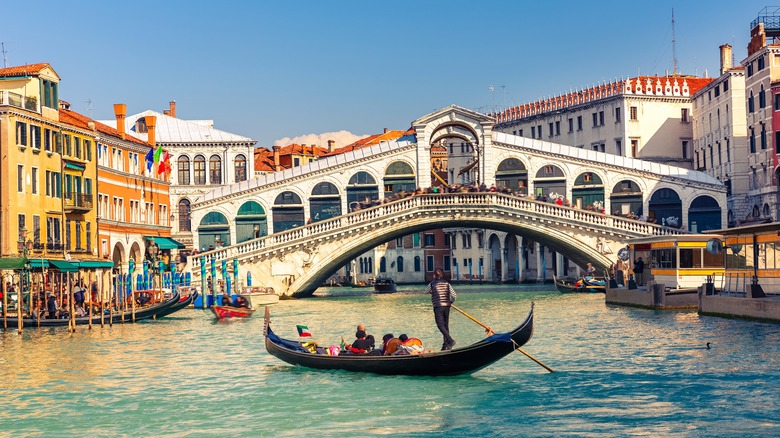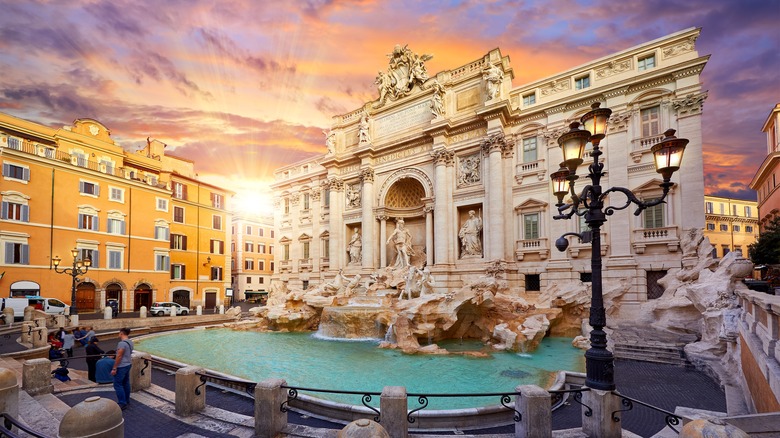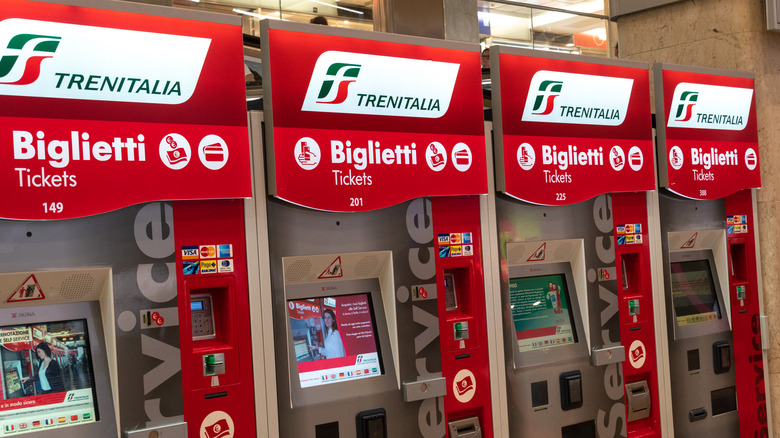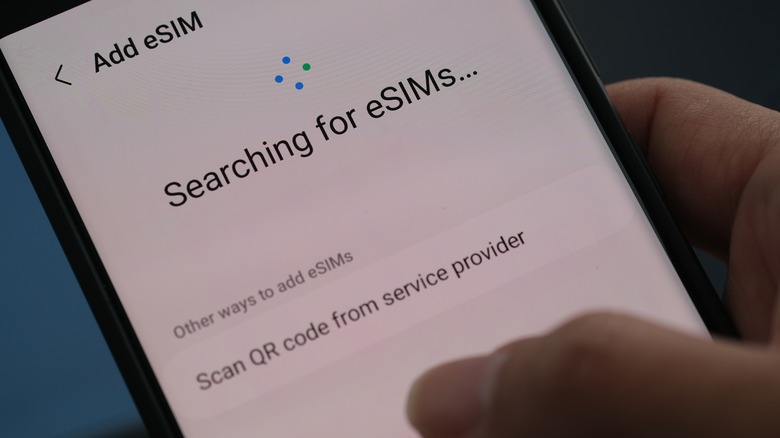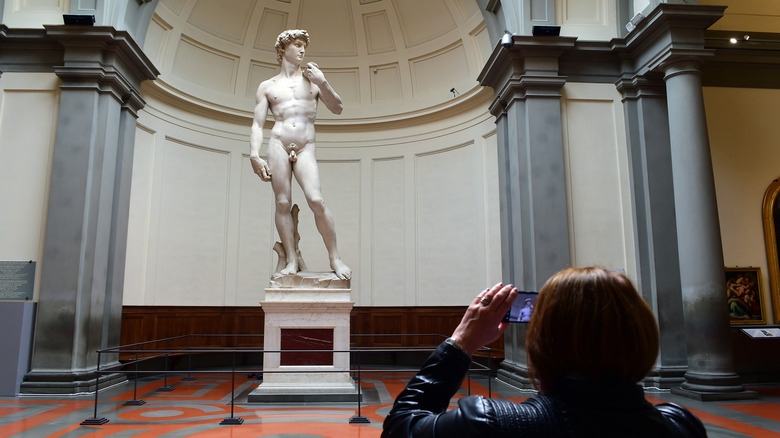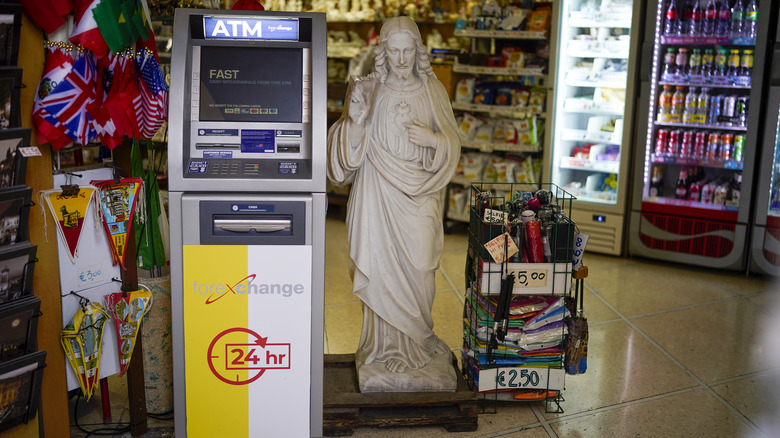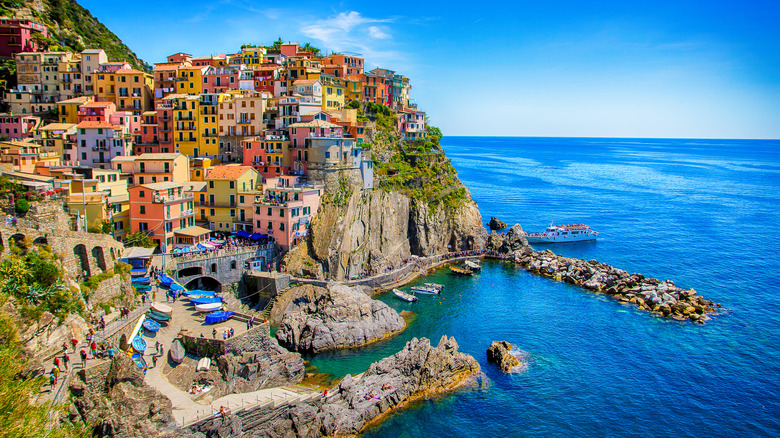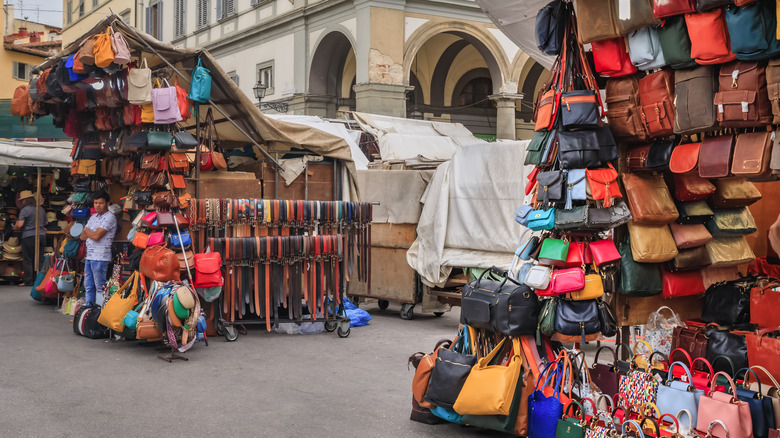The Best Tips That Let You Explore Italy On An Extremely Tight Budget
We may receive a commission on purchases made from links.
Visiting Italy is a goal for most travelers. Its sights and offerings are plenty, from romantic boat rides in Venice and the fascinating history of Rome to the beaches of the Amalfi Coast and the culinary delights in every single city and town. The European country is a magical place, which makes it in demand. According to the World Population Review, Italy is the 6th most-visited country on the planet, with over 38 million people coming to the nation every year, but the experience doesn't come cheap.
On average, a trip for two in Italy can cost upwards of $7,000 per week (via Global Highlights). That price doubles if you're planning a visit with your loved ones, say, to little-known national parks that are perfect for family vacations. However, traveling through Italy doesn't have to be nearly that expensive. In fact, it can be surprisingly affordable if you know where to cut costs. Instead of putting off your dream vacation for another decade or two, consult these tips for exploring Italy on an extremely tight budget.
Check out free attractions across the country
When visiting this country, most people assume that the activities they partake in will account for a significant portion of their vacation spending. However, that's one of the most common myths about Italy you need to forget. This can actually be where you save the most money because some of the most iconic things to do in Italy don't cost a single dime. Many of the country's big churches allow visitors to visit for free. St. Peter's Basilica in Vatican City, one of the most famous churches in the world, doesn't charge for entry. But visitors should expect to wait a while if they don't book a time slot in advance.
Piazzas, which are basically elaborate town squares, are also fun and completely free places to visit in Italy. Most major cities have their own, such as Piazza del Duomo in Milan and Piazza della Signoria in Florence. Even major attractions like The Trevi Fountain and Galleria Vittorio Emanuele II are completely free to visit at any time. But keep in mind that there are strict rules tourists must know before visiting Rome's Trevi Fountain.
Get an Aperitivo every night
Aperitivo is an early dinner tradition in Italy that can be a blessing to budget travelers. While each establishment's offerings are a little different, restaurants typically offer a set of snacks and drinks for a reduced price during this time. How it works is that a guest purchases a single drink and they are given a spread of snacks or even access to a buffet. The term "snack" is used lightly because many places pretty much provide guests with an entire meal during aperitivo time.
In Italy, aperitivo is typically offered at restaurants and bars from 7 pm to 9 pm. Participating in this fun custom is a great way to save money because you only have to pay for the cost of a drink and not the food. While the snack is seen by Italians as a way to prepare your appetite before dinner later in the evening, it is usually a hearty serving that can be enough to keep you satisfied for the whole night.
Purchase a Trenitalia Pass in advance
One of the easy hacks to stay on a budget while vacationing is to opt for affordable travel. Those planning on exploring multiple regions of Italy on their trip will save themselves quite a bit of cash by investing in a Trenitalia Pass. This simple pass starts at €139 ($150), which can sound like a lot of money when you're trying to travel frugally. However, the Trenitalia pass allows you to get around without buying individual tickets each time, which is more affordable than purchasing a ticket for each destination as you travel.
Trenitalia gives visitors the option to purchase a pass that grants 3 journeys for a week, 7 journeys over 15 days, or 10 journeys for 30 days. So, whether you're planning on hitting just Milan, Florence, and Rome during a week-long honeymoon or wandering across all the major cities in Italy during a month of adventure, there is a pass that will work for your trip. A single train ride from Milan to Rome can command as much as the starting cost of a Trenitalia pass, so it's really worth the money, even if you're only visiting a couple of places in Italy.
Use Airalo or Ubigi for a cheap eSim card
Many sightseers plan every last detail of their travel, even down to opting for a late springtime trip, which is the best time to vacation in Italy. But they arrive in the country and realize that their home-based network provider will charge them a bunch of money for roaming services. Using your regular SIM card abroad comes with a ton of additional fees, and they add up fast. For instance, Verizon activates TravelPass automatically, charging $10 daily, when you use your phone in a foreign country that's also registered for TravelPass. When you do the math, you will end up spending $140 by the end of a two-week trip, and that's one of the cheaper providers.
The price of using your phone in Italy doesn't have to be nearly this expensive, though. Visitors can subscribe to a service like Ubigi or Airalo, where they can easily download an eSIM at a much cheaper price. On Ubigi, for example, users can get a 10GB eSIM that's valid for 30 days in Italy and costs just $12 total. The process of turning the Italian eSIM on and off is super simple, and you can use the $100-plus you would've spent on roaming for something more profitable.
Visit museums on the first Sunday of the month for free entry
Museums are one of the best places to visit to get a feel for the country's local culture, especially in a historic place like Italy, which is filled to the brim with these establishments. Unfortunately, as quintessential as this travel experience is, the entry fee for each museum can quickly add up and become a huge expense on your Italy trip. For example, the Uffizi Gallery costs €25 ($27) for standard admission. If you visit just a few museums in Italy, you've already spent over a hundred dollars on admission tickets alone.
Luckily, Italy offers a solution to travelers on a budget — the free museum visit. On the first Sunday of every month, 485 museums across the country are completely free for anyone to visit, even if you're not a European citizen. That's why budget travelers should plan to be in museum-heavy cities like Florence on this magical first Sunday of the month to reap the benefits of free entry.
Don't eat at tourist attractions, only where the locals do
Eating at some of Italy's 94,000 restaurants (as of 2022, per Statista) is one of the best things to do in the country. The problem is that munching on Italian cuisine can take a toll on a tight budget if you don't choose your restaurants wisely. One good rule of thumb is to avoid eating at restaurants near big tourist attractions because these places often hike prices for unwitting visitors.
Stick to authentic, family-owned eateries located outside of the main city center and away from attractions to get the lowest price on the most delicious food. The further you can get away from tourist-heavy neighborhoods, the cheaper the food will be. Another way to reduce your food costs in Italy is by eating the "meal of the day" during the traditional lunch hour from around noon to 2 pm. During this time, many restaurants offer a "meal of the day" spread with multiple courses for a flat rate, and it can really help save some dough.
Do not convert your money into Euros when using the ATM
At some point during a trip to Italy, you will likely need an ATM to have cash on hand. This is a make-or-break moment for a budget traveler because there is a sneaky little trick these machines pull on visitors. When you use an ATM in a foreign country like Italy, the machine will eventually ask if you would like to convert your cash into the local currency.
Most travelers assume they have to accept this conversion in order to get their money. However, it is actually completely optional, and if you choose to accept the conversion, you get a horrible rate that could cost you tons of money. "Markups of 8-10% for standard currencies are absolutely not uncommon," u/samstown23 explained in r/Travel.
Money Saving Expert Martin Lewis agreed, saying, "You do not want this machine to do the conversion for you. You want your card company at home to do the conversion because, even if it's not a good card, it's a better rate," per the Independent. All you have to do to avoid this fate is choose the "no" option and allow your bank back home to convert the funds into Euros for the best rate. This one simple decision can save you a nice amount of money that would otherwise be lost for nothing.
Carry and refill a water bottle instead of buying plastic ones
While travelers probably should not be drinking tap water in most U.S. states, it is actually safe and even recommended across the majority of Italy. Rome even famously has public water fountains all over the place that are completely free to use whenever you need. Since Rome is one of the most expensive cities to visit in Italy, this can help travelers save a surprising amount of money on buying plastic water bottles every day. Not only is it better for your wallet, but it's also way more environmentally friendly.
That's why you should bring a sturdy, easy-to-carry, reusable water bottle on a vacation in Italy. There are a lot of different water bottle options out there, but one of the best for travelers on a budget is the Special Made BPA-free bottle. This silicone bottle collapses to become easily portable; it's affordable, too.
Stay in less popular, more budget-friendly Italian destinations
Calling Italy "expensive" as a whole is an inaccurate, generalized statement because the truth is the country's destinations vary greatly in price. Of course, certain places are infamously costly to visit, such as Rome, Milan, or one of Italy's best beach hideaways on the Amalfi Coast. Staying just a couple of days in one of these locations can cost the same as exploring for weeks in another less popular Italian city. For example, a week-long trip on the Amalfi Coast can easily cost visitors over $3,000 per week, according to Budget Your Trip.
However, not every inch of Italy is so high-priced. In fact, many Italian destinations can even be quite affordable for tourists. On Reddit, several users recommended that travelers on a tight budget visit lesser-known spots that are equally as beautiful as their popular counterparts, such as Bergamo, Verona, and Pisa. Spending a week somewhere like Bergamo can cost as little as $400 (per Budget Your Trip). Sicily and the wine region of Piedmont can also be very cost-effective, even during the busy summer season.
Book your trip for the low season from November to March
Just like budget travelers need to carefully pick their destination in Italy, they also need to consider the cheapest time to travel through the country. The prices for everything skyrocket in Italy during the busy season from May to September, when everybody wants to spend their summer vacation in the European nation. Hotel rooms can be harder to find, and the general atmosphere is a lot busier around this time of the year.
When the off season rolls around in Italy in late fall, prices drop again and the crowds disperse. That's why the absolute best time to visit Italy is from November to March when travelers can get everything from accommodations to tours at an affordable price. The only thing to consider is that visiting Italy during the low season will provide a much different climate than taking a vacation there during the summer. So, be prepared with layers and even rain gear, depending on what region you're visiting.
Participate in a work exchange program
One of the best travel hacks to limit your costs on a trip to Italy is to participate in a work exchange program. These arrangements offer free accommodations, and sometimes even meals or more, in exchange for your expertise in a particular field. It's perfect for visitors who want to get involved in the local Italian culture for an extended period but don't have enough money in the bank to do so.
There are quite a few different websites where you can find work exchange opportunities in Italy, such as Worldpackers and Workaway. Typically, these gigs can involve working on a farm, teaching English, or being an au pair for a local family. As of 2024, Worldpackers has over 200 work exchange opportunities for travelers hoping to spend time in Italy, from Milan to Verona. Alternatively, there are over 500 hosts and organizations offering work exchange on Workaway.
Research youth and senior discounts
Travelers in a certain age range will have access to a whole slew of money-saving discounts in Italy. Hotels, transportation, and many attractions offer discounts to seniors and young people and they can actually be pretty substantial. However, budget-conscious travelers that fit this criteria will need to go looking in the right places for these incredible deals.
Trenitalia, one of the main public transportation providers in the country, offers an insane travel deal for seniors and young people in Italy. The railway operator offers travelers under age 30 a discount of up to 70% off certain tickets, and they have a similar program for senior citizens over age 60 with 50% off. That can bring down the cost of traveling across Italy on the train by a huge degree. Visitors can find additional deals by searching on forum sites like Reddit and double-checking ticket types for attractions in Italy to see if they offer any age-based discounts.
Get affordable souvenirs and fashion pieces at local markets
Italy's shopping scene is one of the best in Europe, and bringing a little treasure back from your trip through the country is a must, even if you're traveling on a strict budget. Luckily, Italy has places to shop for any type of budget. For individuals hoping to spend the least amount of money possible, the best place to go shopping is at local Italian markets.
There are tons of markets across the country to pick up clothing, jewelry, and other types of trinkets. These stalls have way more unique pieces for a much more affordable price than official souvenir shops, so it's a win-win. Many Italian cities even have a shopping specialty. For example, the city of Florence is known for selling leather products at its markets, and the Lake Como area is famed for its silks, which can be surprisingly affordable in this region even though it's a high-end good.
Join free walking tours around major cities
Joining a walking tour is one of the first things that visitors should do in Italy because it gives them a solid introduction to the history and culture of the area. These experiences can be pricey if you're booking a paid tour around a major city. However, budget travelers will be relieved to know that there are actually a bunch of free or pay-what-you-wish walking tours with friendly, local guides that can help you get to know Italy.
All visitors have to do is head to a website like GuruWalk or Free Walking Tour Italia and choose the city they're hoping to tour. These budget-friendly excursions happen everywhere, from Verona to Rome. Then, they'll be presented with a range of tours that are completely free in their city of choice, and they can simply reserve a spot for the next availability.
These aren't generic, run-of-the-mill tours that leave you bored out of your mind, either. They can focus on anything from teaching visitors about a city's history and hidden gems to food tours that bring you to all the best places to eat in Italy. While these tours are technically free to join, visitors should still plan to tip their guide with a little bit of cash, as this is usually expected. A tip of $5 to $25 is recommended, depending on how much you enjoyed the experience and guide.
